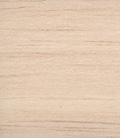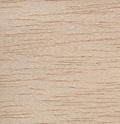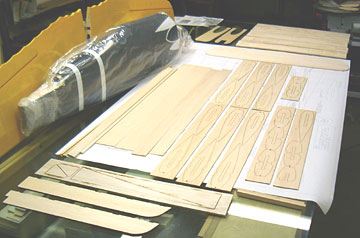|
|
|
|
Balsa
Wood
Balsa Wood is the traditional construction material
used in flying model aircraft. Balsa comes in several shapes and sizes and
you will need some of all of them if you scratch-build.
If you build from
kits, you will still need a piece here and there. Sheet balsa is the most
basic. Useful sizes are from 1/32" to 3/8" with some sticks, tri-stock and
blocks to round things out. If you can saw your own sticks and triangles
you will save A lot of money.
Generally speaking, you will save money buying
bulk or larger sizes. For example, if you buy 4" wide by 48" long balsa
sheets, you will generally pay less per cubic inch than if you buy 3" x 36" wood.
Sometimes it is just the opposite because the size may be difficult to obtain for
various reasons.
Also see
|
|
|
|
Wood Selection
If you scratch build, it is important for you to
be able to select your wood properly. You should also be able to determine
what kind of balsa to use in various situations.
For example,
wing spars
should be strong and straight-grained. They tend to be heavier wood, but
just because a piece of wood is heavy does not mean it will make good wing spars.
Grain Pattern
The grain-pattern and density are the determining
factors for selecting a piece of wood. I suggest you use an accurate
postal scale or beam-balance to weigh your wood.

 |
Two typical Balsa Wood samples. Balsa has a
variety of grain patterns. In some cases it is very important to
select the correct grain balsa. Example are long, load-bearing
members such as spars and longerons. Another
example is planks such as used for the tail surfaces of many sport models.
Selecting the incorrect grain will almost guarantee warping.
In other cases, the grain isn't so important such as using filler
blocks that are primarily cosmetic. In these cases weight is the
most important issue. Another consideration is consistency of the
block so that it carves and sands uniformly.
Click the images to see them at higher resolution. Both of these
pieces were sanded with very fine glass finishing paper. The image
at the bottom in particular has very deep grain that no amount of sanding
will remove. Further sanding may remove grain that is open now, but
will open other grain.
This is what makes balsa so difficult to finish and why some type of
covering such as
tissue,
silk, silkspan,
fiberglass or other will make finishing faster and give better
results. If your goal is to create a grain-free finish then you should
always apply a covering first. If you use sanding sealer or primer
to fill the grain then you probably won't hide the grain completely anyway
and you'll add a lot of weight to the model. Using a covering over bare
balsa will result in a lighter finish. |
Balsa is classified as having one of three grain
patterns:
-
A-Grain
A-Grain wood has long, straight grain
lines and is best used for sticks. However, it warps easily and should not
be used in large, unsupported planks such as tail surfaces.
A-grain tends
to bend more easily than B or C-grain and can be used for turtledeck
sheeting,
leading edge sheeting (when there are plenty of supporting
ribs) or small radius
curves that will cause the sheet to support itself.
-
B-Grain
B-Grain wood has mid-length grain that is
not as long as A-grain. It is stiffer than A-grain, yet does not crack as
easily as C-grain. Therefore it is a good choice for flat sheets such as
fuselage sides, leading edge and
trailing edge
sheeting, ribs and formers and
other general uses.
It is usually safe to pick B-grain wood when you do not
know the correct wood to choose. However, you should always use A-grain
for long, load-bearing members such as fuselage
longerons and wing spars.
-
C-Grain
C-Grain wood has a mottled appearance due
to its very short grain pattern. Proper use of this wood will result in
models that are light and strong. However, C-Grain is the hardest wood to
judge and can vary dramatically in strength with little indication of being weak
or strong. For example, C-grain can appear to be strong because it is
stiff across the grain. The same piece of wood can also be pulpy and weak
in spite of how strong it feels when you try to flex it.
|
|
|
|
Wood Defects
-
Poor grain pattern (veers wildly all over the sheet)
Generally useless wood.
-
Non-uniform density
If the density is consistent along the grain,
but varies across the width of
the sheet, then I will use it if I can strip a piece off that is all the same
density. I do not use the full sheet at one time because it will not sand
evenly. For example, I wouldn't use it for wing sheeting.
-
Hopelessly twisted like a pretzel
I do not buy any wood that is severely warped. A little warpage is
normal and OK.
-
Knots
Balsa knots are tiny and nothing to worry about.
-
Insect damage
Looks like 1/32" holes drilled at angles through the wood. The mills
do a good job of weeding badly insect damaged wood out. I have never seen
a piece that I would discard due to this kind of damage.
|
|
|
|
Mill Defects
-
Joined wood
Some mills glue blocks of balsa together before sawing it. There is an
obvious line down the sheet of wood where it has been joined. While there
is no fundamental reason not to buy this wood, sometimes the sheet has two
different densities or grains of wood.
For example, half the sheet may be
soft and flexible and the other half may be heavy and stiff. If the wood
seems to be the same across the sheet, then it is ok to buy.
-
Sticks sawed or stored in such a manner to
have taken on a permanent warp
These sticks should be avoided because they will
create unwanted stress in your model after they are braced into the correct
shape and glued into the structure. Often these sticks were stored standing up or they bowed after
being cut from a sheet.
Sometimes wood looks like it just did not go
through the saw right and has a long 'S' curve shape.
-
Tapered cuts
You would be surprised if you knew how many
sheets of balsa tapered in thickness across the width of the sheet. I have
seen wood that varied by more than 1/32" in thickness. While that may not
seem like much, think of what will happen if you join these together to sheet a
wing. You will have to sand a lot of wood away to get the sheet even and it
will end up being too thin.
|
 Tapers across
thickness (end grain shown) |
Similar to this is wood that tapers towards the edges from the middle.
I do not have an explanation for how this happens, but I have seen it happen on
occasion.
|
 Tapers from
middle to edges (end grain shown) |
The above images are more extreme than the actual problem, but they get the
idea across. |
|
|
|
Working with Balsa
-
 All wood needs to be acclimatized to your shop before you use it. In
other words, when you buy a sheet of wood (or a new kit)
from the local hobby shop, you should let the wood sit in your shop for several
days before using it. All wood needs to be acclimatized to your shop before you use it. In
other words, when you buy a sheet of wood (or a new kit)
from the local hobby shop, you should let the wood sit in your shop for several
days before using it. Wood shrinks and swells significantly. If you
glue a piece of wood that you just brought from another climate (such as from
your air-conditioned home into your non-climate-controlled shop) to another
piece of wood that has been in your shop then you are asking for warps.
-
Because Balsa is soft, there is a general conception that
it is easy to work with. That is both true and false.
Balsa is easy to cut and to shape, but it can be difficult to
smooth. Balsa end grain tends to fuzz — especially on compound curves
such as wing tips. There are a couple ways of dealing with this.
First, shape the part as you would normally. Then finish sand using
finer and finer papers until you reach about 800 grit (wet or dry used dry).
If the fuzzing still occurs and it will cause problems, then rub some
model airplane cement
in the grain to harden it and make it easier to sand off the fuzz. You
can also brush on a coat or two of
model airplane dope.
-
Sheet balsa always needs to be trued if you need it
to have a
straight edge (wing sheeting, for example). I have had to cut as
much as 1/2" off on edge to get it straight because of the amount of curve it
had. Do not ever assume that the edge of a sheet of wood is straight when
you buy it. It is not.
-
Sometimes after you slice a piece off a sheet it
will bow. At this point you can do one of two things. Normally
what I do is go ahead and use the sheet and remove the bow with pins, tape or
some type of clamp. The other option is to slice the sheet a little
wider than you want at first because there is no way to tell in advance if a
sheet will bow after it is cut. By cutting it oversize, the sheet will
probably bow as it would if you cut the sheet to size, but there is still wood
left to trim or sand.
-
If the edge has to be perfectly straight then I weight a sheet down
with my heavy straight edge with just a quarter inch or so off the edge of my
bench. Then I use a long sanding block to true the edge.
-
When sanding a thin sheet of balsa on one of the
faces, do not sand back and forth. Sometimes the block will grab the wood
on "back" stroke and crumple the wood.
Use "away" sanding strokes on thin wood (1/32").
-
I love my
Microlux Table Saw. There are other small table saws on the
market. This is the only one I have owned, so I can not compare it to other
makes. The best thing about it is that when I need
matched sticks, such as wing spars, I can cut them from a sheet of wood
instead of standing in a hobby shop trying to match sticks through scientific
bouncing, bending and guessing weights. The bonus is I save a lot of
money on the cost of stick wood. Before I cut the sheet into
sticks, I use a colored marker on the end of the sheet so I know which sticks
go together.
-
Do not buy just
the lightest wood you can. And do not buy heavy wood that bends easily.
The whole point of heavy wood is to have stronger, stiffer wood. Heavy, flexible
wood is generally useless.
-
When using balsa sticks, make sure the grain does not
suddenly veer off the edge of the stick. If it does, it will crack there
if subjected to a load. You could use this stick for a leading edge that
gets capped, sheeted or otherwise reinforced, but do not use it for spars or
longerons.
The same thing applies to any piece of wood you would use for a spar.
-
Every time you need a part, go to your scrap box
first. Find the smallest piece of wood that is big enough to do the job.
Be sure to hang on to small cut-offs of special shapes such as triangle stock.
I save anything that is at least 1/2" long and put them in a baggy so they are
easy to find.
|
|
|
|
Balsa Wood Sources
Your local hobby shops should carry the most common sizes of balsa sheets, sticks,
triangles and trailing edge stock. Hobby shops tend to be more expensive
than bulk suppliers.
If you build from kits then it is probably best to buy just what you need
from a hobby shop rather than by mail or internet. The reason being that
you can hand select the wood so that it is most appropriate for the application.
Balsa is also available in some art and craft stores, but this is the most
expensive source I've found as well as having the smallest variety.
I buy my wood in bulk because I scratch build most of my model aircraft.
Buying in bulk means getting a variety of weights of wood so I always have what
I need. I also order contest balsa in bulk when it is available.
I order my wood from
Balsa USA. I have
also ordered from Sig
Manufacturing in the past but their wood is more expensive. I also
think Sig wood has a nicer finish. Balsa USA wood tends to be a little on the
rough side, but I sand everything anyway so it's not a problem. I'd rather
save the money.
|
|
|
|
|
|
|
|
Back to
Construction Materials
Airfield Models Home |
|
|
|
Copyright © 2002 Paul K.
Johnson |
|
|
![]()